If you know someone Thai or ever went to visit Thailand, you would know about our habit of eating all day long. Yes, we are very similar to hobbits, we’re only taller with normal ears and no hairy feet.
That’s why we can never serve anything “Supersized”. Not only that it would be unnecessary, but it also jinxes our next meal. I mean, if you could divide our eating times into actual meals. I normally don’t bother, especially when we eat every two hours. We actually ran out of names to call every meal specifically. We have ข้าวเช้า Khao Chaow=Breakfast, ข้าวเที่ยง Khao Thieng=Lunch, ข้าวเย็น Khao Yen=Dinner. Then we call all the in-between meals ของว่าง Khong Wang=Snack or ของกินเล่น Khong-Gin-Len=Snack.
Can you guess which one is my most favorite meal? It is always the snack. It’s small, it’s tasty and it’s not a big deal to grab, unlike dinner, which is the biggest meal, with many different kinds of dishes. One of my favorite all-time snacks is fresh spring rolls. When I was living in Thailand, whenever I saw one for sale I had to try it. They sell them at vendor pushcarts on the street or vendors in the open market, in restaurants or at food courts, mostly in Bangkok. There’s a very slim chance of finding them outside Bangkok, but not impossible. It’s called Por Pia Sod (ปอเปี๊ยะสด) or Po Phia Sod in Thai. It’s a soft roll with sweet sauce on top.
The origin of the fresh spring roll is from the Teochew Chinese, who are the majority of the Chinese immigrants in Thailand. We smoothly adopted their cuisine until sometimes we forget that it wasn’t really ours. There are other kinds of fresh spring rolls, such as Vietnamese spring rolls that use rice paper as a wrap, and also Hainanese and other Chinese Tribes, too. If you’ve ever had some soft spring rolls with slightly spicy red sauce, either inside the rolls or outside spread on the top, those are Hainanese fresh spring rolls, which I will write about later. They are found quite easily in the Southern parts of Thailand such as Phuket, Krabi, Trung or Songkhla.
The spring roll that is my focus this time has these main ingredients rolled up in a wheat wrapper: cucumber, cooked but still crunchy bean sprouts, Chinese sausage called Goon Chiang (กุนเชียง) in Thai and Teochew dialect (means sausage), and Chinese rillettes, called Moo Tung (หมูตั้ง), egg ribbons, and marinated tofu and sometimes crab meat. Then a sweet, sticky sauce is poured over the roll and it’s always served with mustard, pickled, sliced chilies and green onions.
This combination creates a balance of flavor and texture through salty rillettes, marinaded tofu and Chinese sausage, crunchy vegetables, sweetness from the sauce, and sourness from mustard and pickle chilies. Sometime these spring rolls are served as an appetizer during lunch or as a light lunch itself.
There are a few variations of the fillings, because making rillettes (yes, the “s” is on there even though it’s singular) or obtaining it isn’t that easy these days, even in Thailand. Chinese style rillettes generally is made after a Chinese ceremony because they used a pig head as part of the offering to the gods or the dead, and you know that neither gods or ghosts won’t physically “eat” them, right? So someone has to.
Let me tell you how the gods and ghosts have been deceived in this process. In the old time, a ceremony was supposed to be done with a WHOLE pig, whole ducks and whole chickens. It’s a huge ceremony, and the family will be eating those meats long afterward. Then it became quite difficult to kill the whole pig for many reasons. So they started offering the piglet. Eventually even the piglet was still not small enough, so they just offered the head, belly and tail, pretending that it was the WHOLE pig…haha…. These days even the belly and the tail are no longer offered. The lesson from the story is, eat the pig while you are still alive!
The pig head isn’t really edible, as everyone already knew, but you have to respect the Chinese and the French for finding a way to make the leftover protein edible somehow, and that’s where rillettes came in the picture.
The French make rillettes by curing the meat (as little as there is) with salt first before they cook it for a long time, usually in its own fat; at least that’s the way I know. The Chinese don’t cure the meat but throw all the skin, bones, meat and fat together in a little bit of water with some spices and seasoning, then cook them together until the whole thing falls apart.
So after the Chinese ceremony at the Chinese New Year, the pig’s head, ears and some pork belly would all be chopped up, the bone scraped and everything went in the pot together. Chinese five spices was normally added, with garlic and soy sauce used as seasoning. The Chinese – Thai would add cilantro root. Then the pot would be boiled over low heat for a long time until the ingredients break apart and the jelly from skin and bone marrow became part of the soup.
Once the desired consistency is reached, the bones would be fished out and the whole soup would be chilled in a mould. The next day you get Moo Tung, that is, rillettes, ready to use. Don’t worry, when I make rillettes again I will give you the exact recipe. This time I didn’t measure anything, sorry!( It’s my bad habit in cooking. You can just omit rillettes if you can’t find it or you want your spring rolls to be “healthier”.)
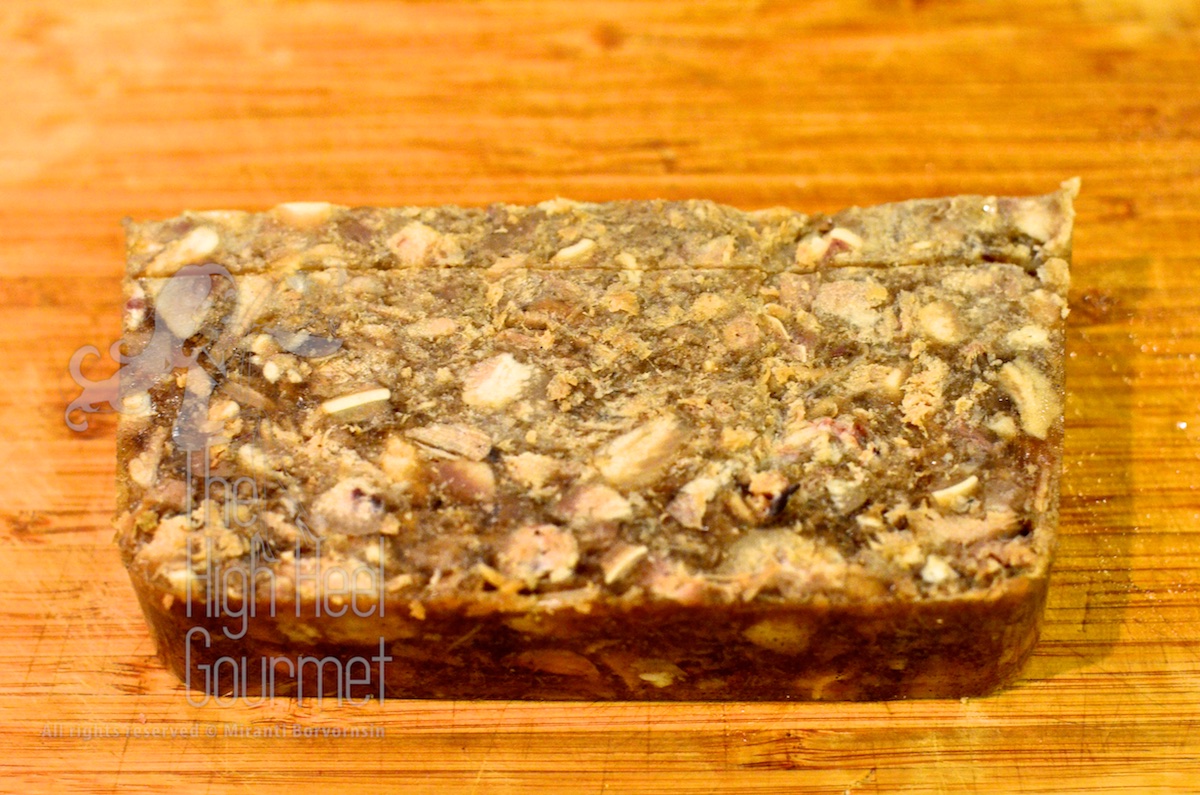
This piece was cut from the big block I made. You want to keep this in the fridge until you’re ready to use it, or else it will get soft. I made it without adding gelatin.
OK…back to the variations of the spring roll filling.
1) Original: Bean sprouts, cucumber, marinated tofu, egg ribbons, Chinese sausage, rillettes, crab meat.
2) The lesser version: Do it with less crab meat and put it on top instead of inside, more as garnish.
3) The loser version: No crab and no pork rillettes inside.
4) The vegetarian version: No crab, no rillettes, no Chinese sausage. This version used to be identified by the egg ribbons on top, but these days you can’t tell by that any longer since the “loser version” that has Chinese sausage inside probably has the ribbons on top too.
5) The modified version: This is the one where they stir-fried tofu and pork meat together with soy sauce and garlic, but has no pork rillettes inside.
Fresh spring rolls would not be complete without the sweet sauce. The sauce is the dealmaker or the deal-breaker for me. If the sauce is good, it can bring the bad filling to life, but bad sauce will easily kill a perfectly good spring roll, even with top quality fillings.
Before we go to the sauce part, we must discuss the marinated tofu, because part of the sauce comes from the marinade we use with the tofu.
Ingredients for the marinated tofu
Hard tofu or pressed tofu, one block or 8 oz.
Chinese five spices 1/2 teaspoon
Sweet dark soy sauce or dark soy sauce 2 – 3 tablespoons
Vegetable oil 2 teaspoons
Water, enough to cover the tofu
Method
1) Cut tofu into strips, as shown in the picture.
2) Add the oil in a saucepan and set over medium heat. As soon as the oil is hot, add the Chinese five spices and fry the spice over medium heat until fragrant.
3) Add the tofu, then add the soy sauce, then water, just enough to cover the tofu and bring the contents to a boil, then turn off the heat.
4) Let it marinate at least half an hour. You can even let it marinate overnight.
5) Take the tofu out of the marinade and reserve the marinade for the sweet sauce.
Now, let’s see what’s in that sauce.
Ingredients for the sauce (for 2 people, or 4 spring rolls)
Sweet soy sauce (If you can’t find it, you can mix light soy sauce with molasses, 1:1) 1/2 cup
Sugar 1/2 cup
Light soy sauce 1 tablespoon
Seasoning soy sauce 1 tablespoon (such as Maggi, Golden label or Golden mountain brand)
Tamarind pulp 1 tablespoon
Salt 1/2 teaspoon
Corn starch 2 tablespoons
Water (to mix with the corn starch) 2 tablespoons (You can use the sauce left over from marinated tofu)
Sauce saved from marinated tofu 1/2 cup (If not enough just add more water)
Method
1) Mix everything in a saucepan and set it over medium heat, stirring constantly with a wire whisk until it bubbles.
2) You can keep it warm over extremely low heat while you are making the spring rolls, to prevent it from getting cold and clumping, or let it cool and make all your spring rolls, then warm the sauce up just slightly in a microwave just right before you pour it over the rolls.
3) If you have leftover sauce, you can warm it up until it bubbles again and put it in a clean jar. The sauce can be kept in the refrigerator for a long time. I’ve sometimes kept mine for many months.
Spring rolls need a wrapper, right? Otherwise it would be called a salad. I usually use frozen spring roll sheets. You just have to find them at the Asian market or, in CA, at Whole Foods or Trader Joe’s. Even Ralph’s carries them.
Ingredients for the spring rolls (4 rolls for 2 people)
Cooked bean sprouts (I cook mine in the microwave for 1-2 minutes) 1 cup
Half a Persian cucumber or half a regular cucumber, julienned or quartered (see note #1)
One cooked Chinese sausage, julienned or quartered (I cooked mine in the microwave)
2 Eggs
4 sheets of wrappers (I used 8”x8”)
(Optional) Rillettes 4 strips 1/2” x 1/2” x length of the wrapper.
Marinated tofu 6 strips (I break 2 of the 6 strips in half so I get a piece and a half, because my wrapper is longer than the length of the tofu)
(Optional) Crab meat 1/2 cup
Sweet sauce that you made 1 cup
Serrano Chillies, soaked in vinegar
Yellow mustard, or any sour fine grain mustard 2 tablespoons
Green onions 4 stalks (called spring onions in the UK and Down Under)
Method
1) Making the egg ribbons. Beat the eggs so the are well-blended, but make sure you don’t add too much air into the eggs. Heat a flat pan, 10” diameter, over medium heat. If you don’t have a non-stick pan, spray cooking oil on the surface, but if you are using a non-stick pan you don’t need the cooking oil.
2) Pour the egg, about 1/4 cup, on the pan and swirl around really quick so the egg coats the bottom of the pan. Put the pan back on the stove, wait until the edge of the egg sheet lifts away from the pan, about a minute, depending on your stove.
3) Lift the egg sheet with your hand and flip the other side down to cook. Once both sides are cooked, take it out. Make another one until the egg batter is gone, stacking the finished egg sheets together. You should have about 3-4 sheets at least. If you have less than 4 sheets using a 10” pan, your egg sheet is a little too thick, but it’s ok.
4) Roll all the egg sheets together
and start cutting them into ribbons about 1/4” thick or smaller. NO BIGGER than 1/4” strips. I cut them really, really thin, like 1/16” strips, but that’s just my preference. Try different size strips and see what you like.
6) Put 1/4 cup cooked bean sprouts, one quarter and a half (just to cover the whole length of the wrapper) of cucumber, one quarter of the Chinese sausage, about a quarter cup of egg ribbons, rillettes and tofu in the wrapper and roll. If you are using crab, you can put it in or save it for garnish.
7) Cut the roll into bite-sized pieces, about 1” long, with a SHARP knife. Do not complain to me if everything falls apart because your knife is dull. The roll won’t stay rolled if your knife isn’t sharp enough. Use the sharpness to cut, not the pressure on the knife.
8) Put them on a plate, two rolls for each plate (I just do it the way they serve in Bangkok, but I think with these pre-made sheets two rolls is overkill. It’s already a meal! For snacking one is enough.) Then pour the sweet sauce over the cut rolls.
9) Garnish with crab meat (or more shredded egg ribbons if you don’t have crab meat), and serve with mustard, the pickled chillies and spring onions.
10) If you still need further instruction, or your spring rolls don’t look good enough, make another batch. It’s almost time for another snack, anyway…lol…
Note
1) Julienne or quartered?…You can just quarter the cucumbers lengthwise if you don’t want to julienne them. Restaurants and street vendors in Bangkok don’t julienne them either, but I like the texture of a julienned cucumber better. Some people prefer the quartered texture better. They say they can chew better on a bigger piece of cucumber (crunchier) or a full piece of the Chinese sausage, but I like them the same texture as the cooked bean sprouts. I feel like it blends better. This is your personal choice.

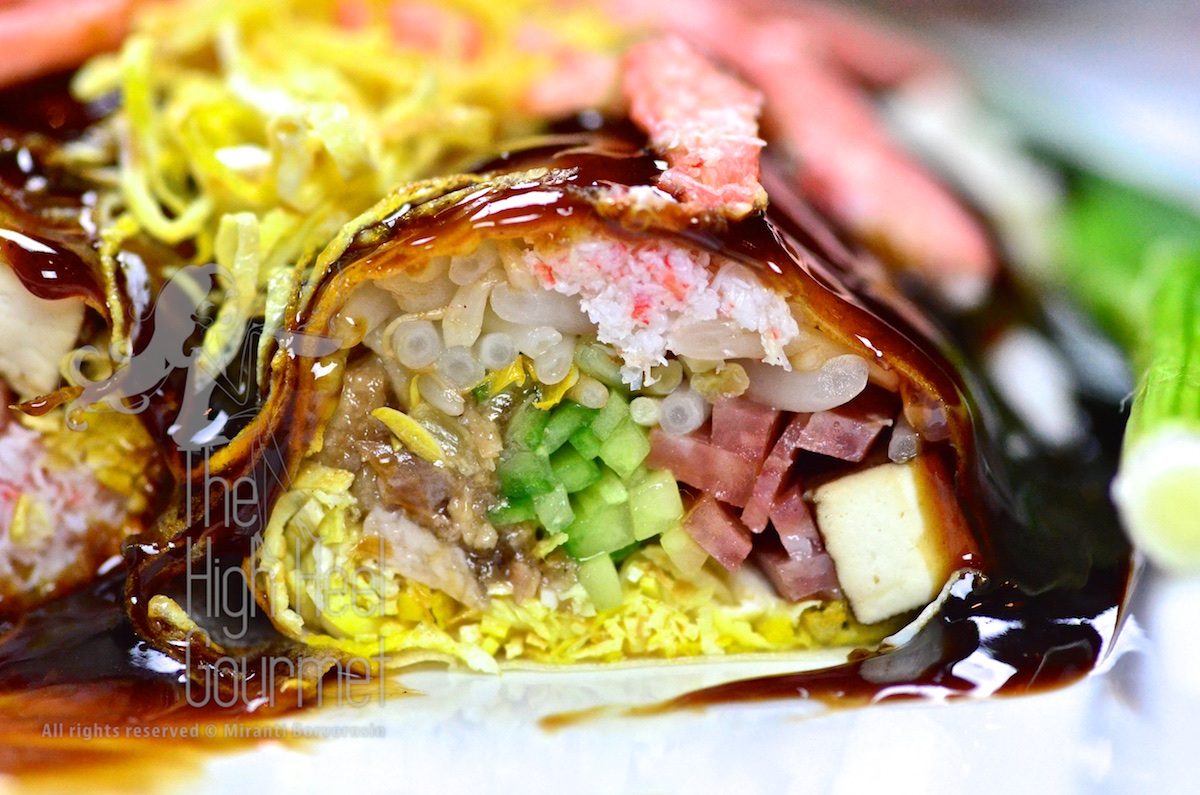
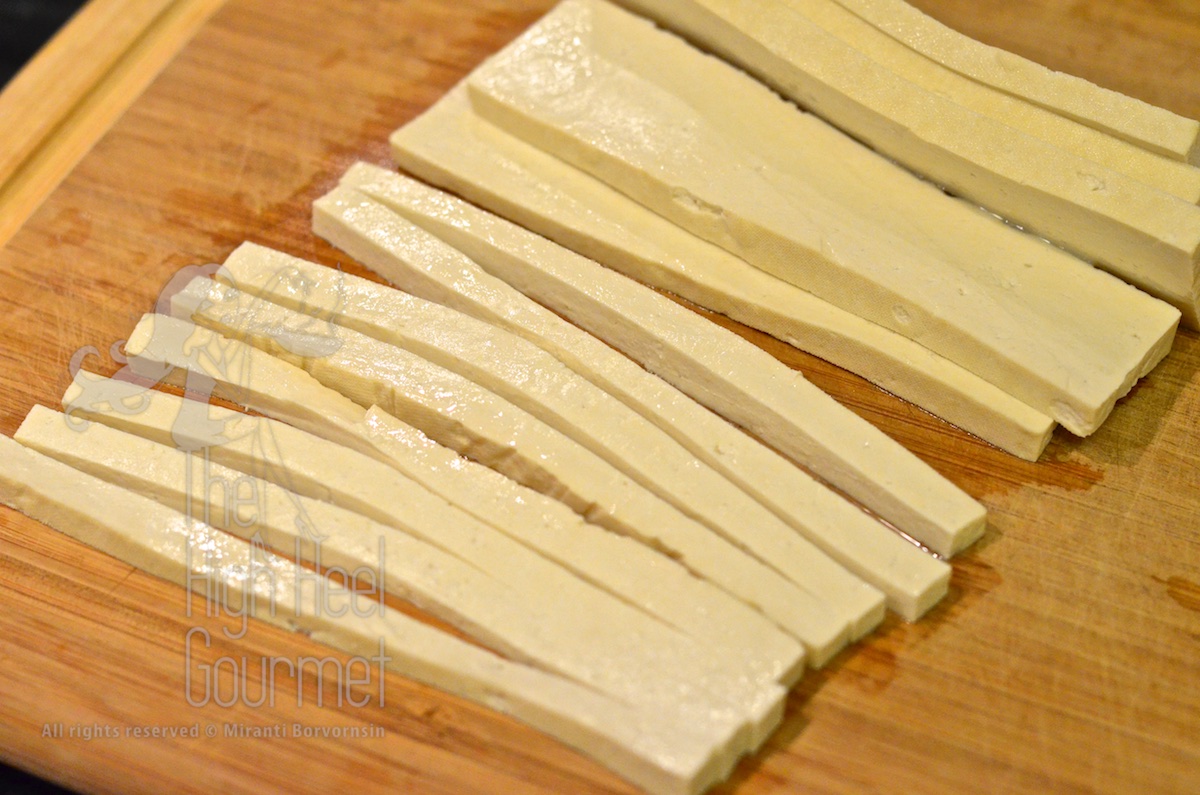
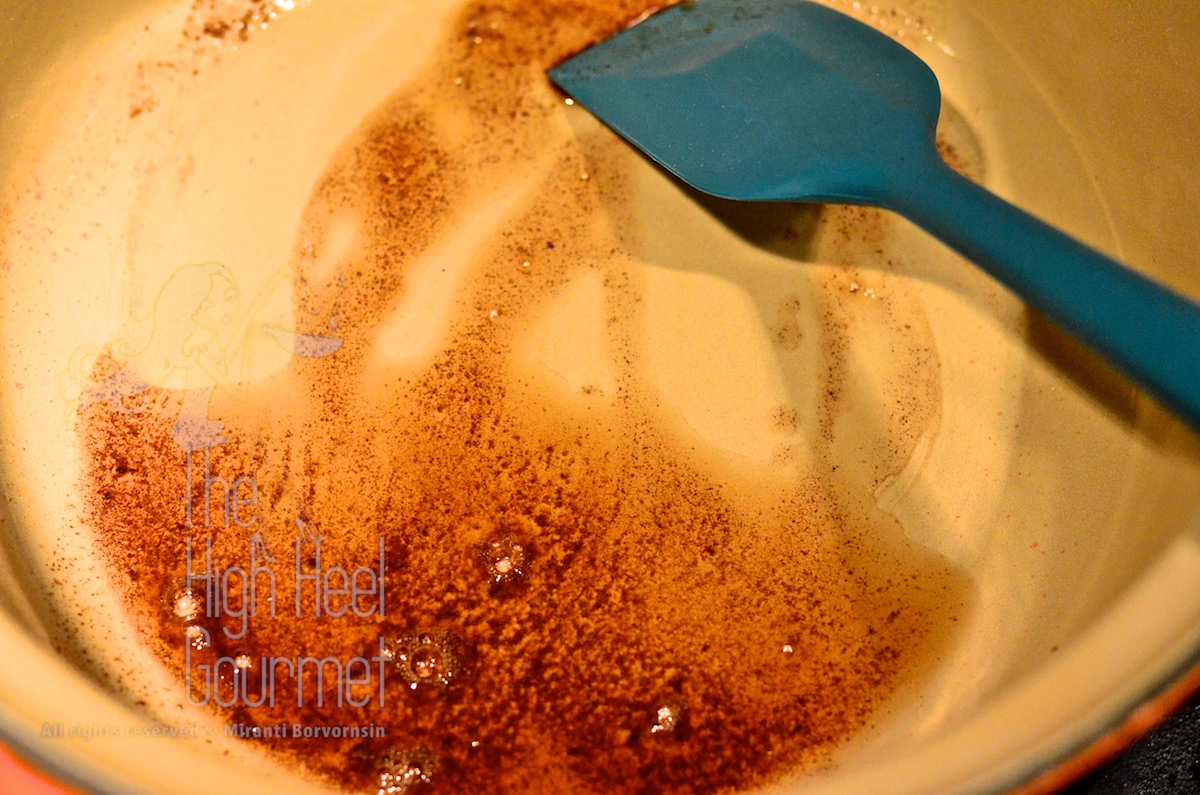
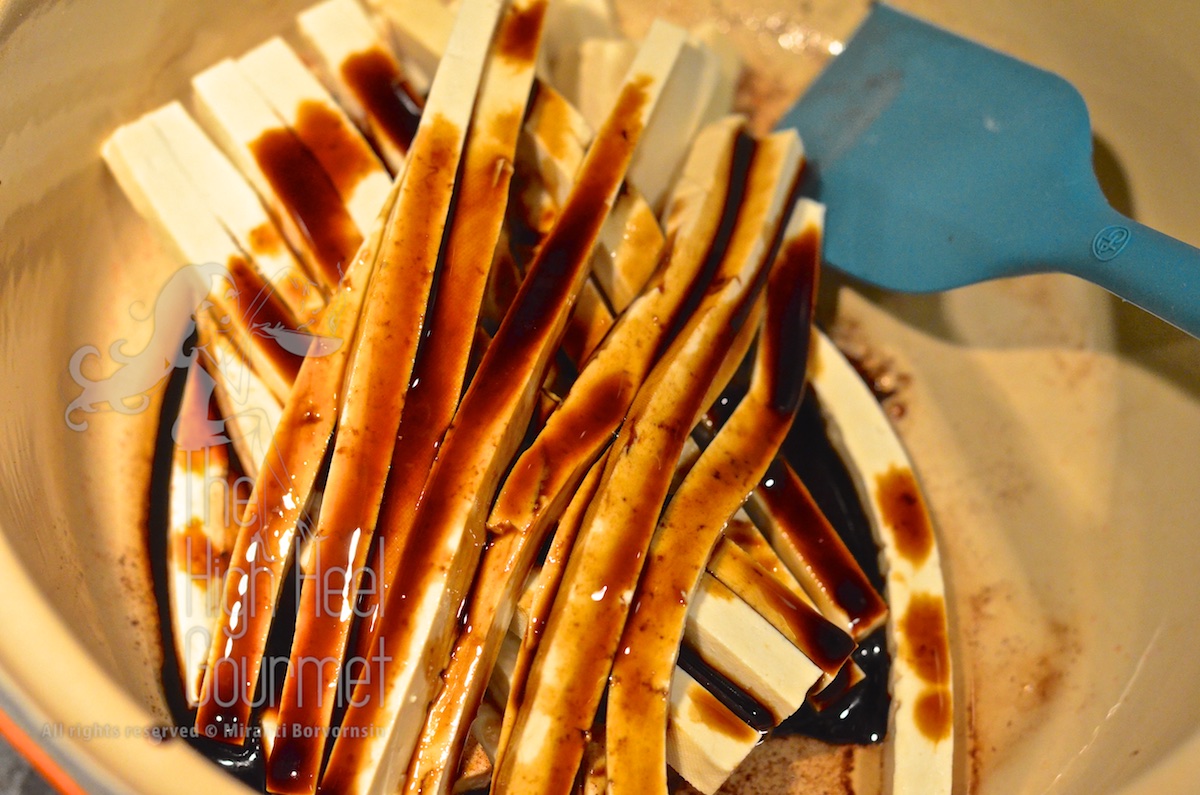
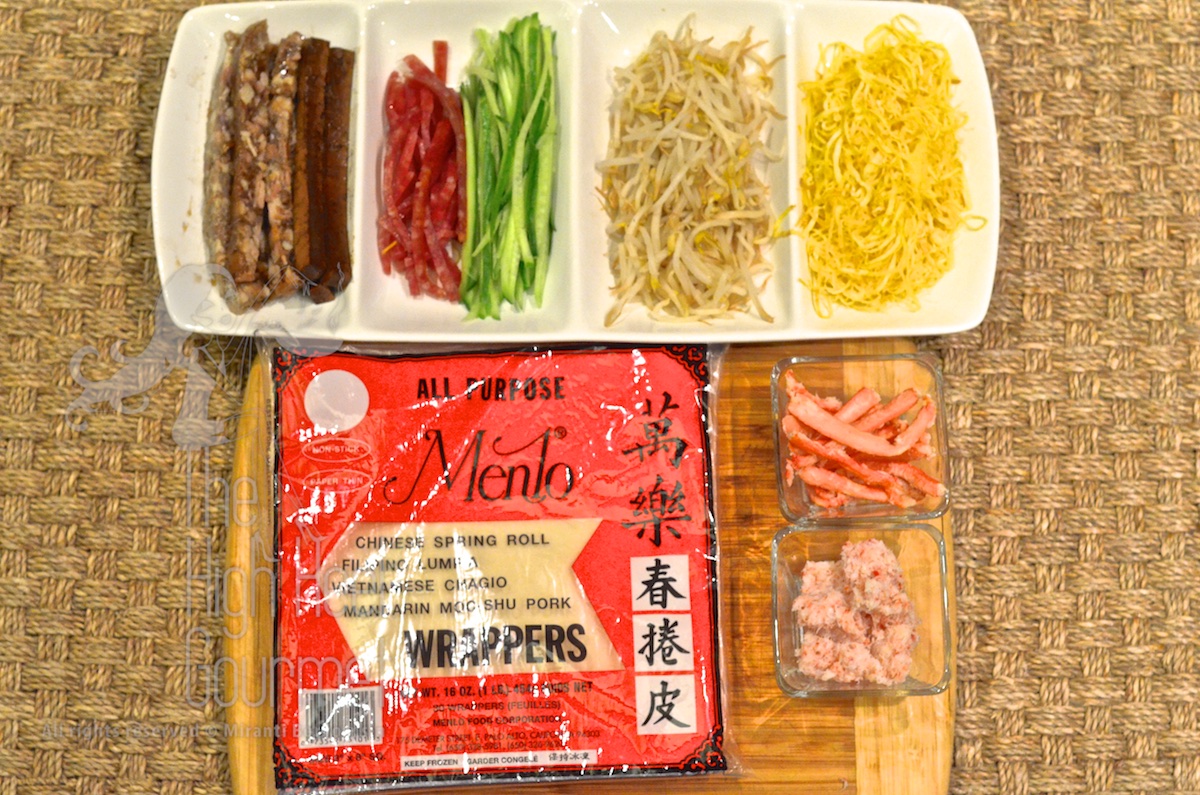
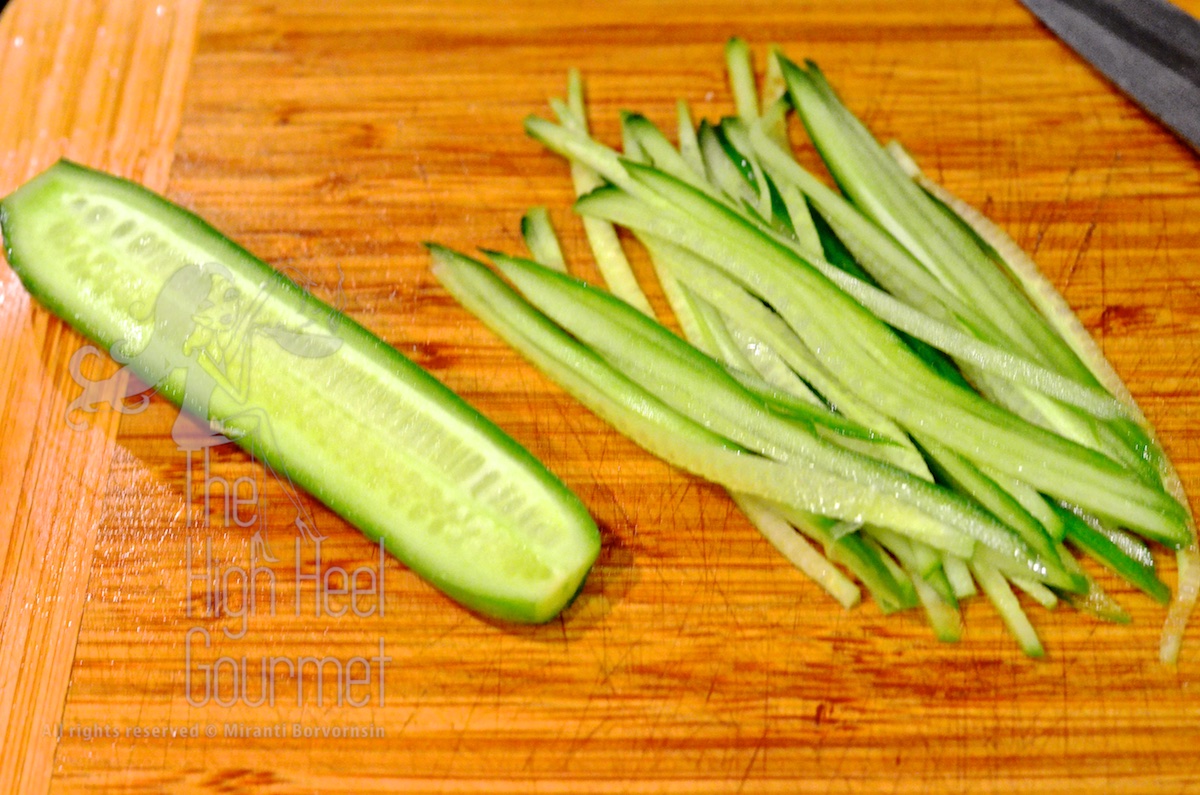
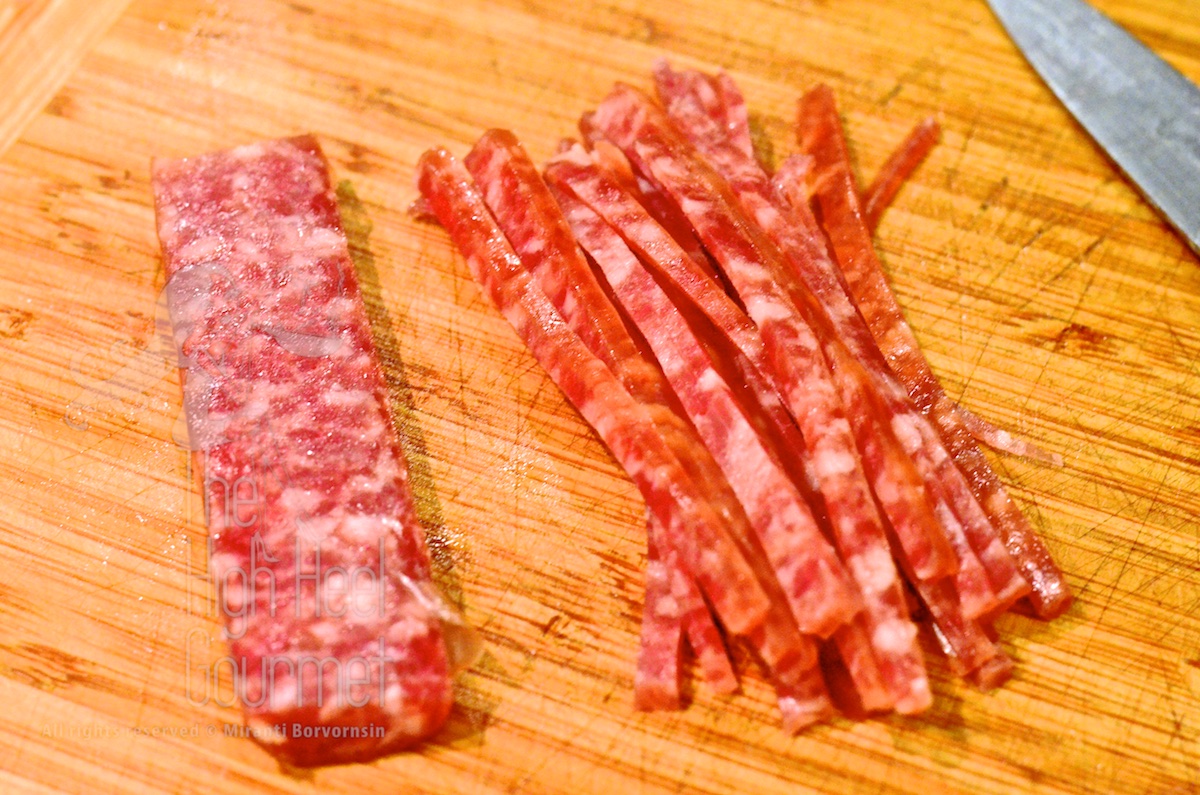
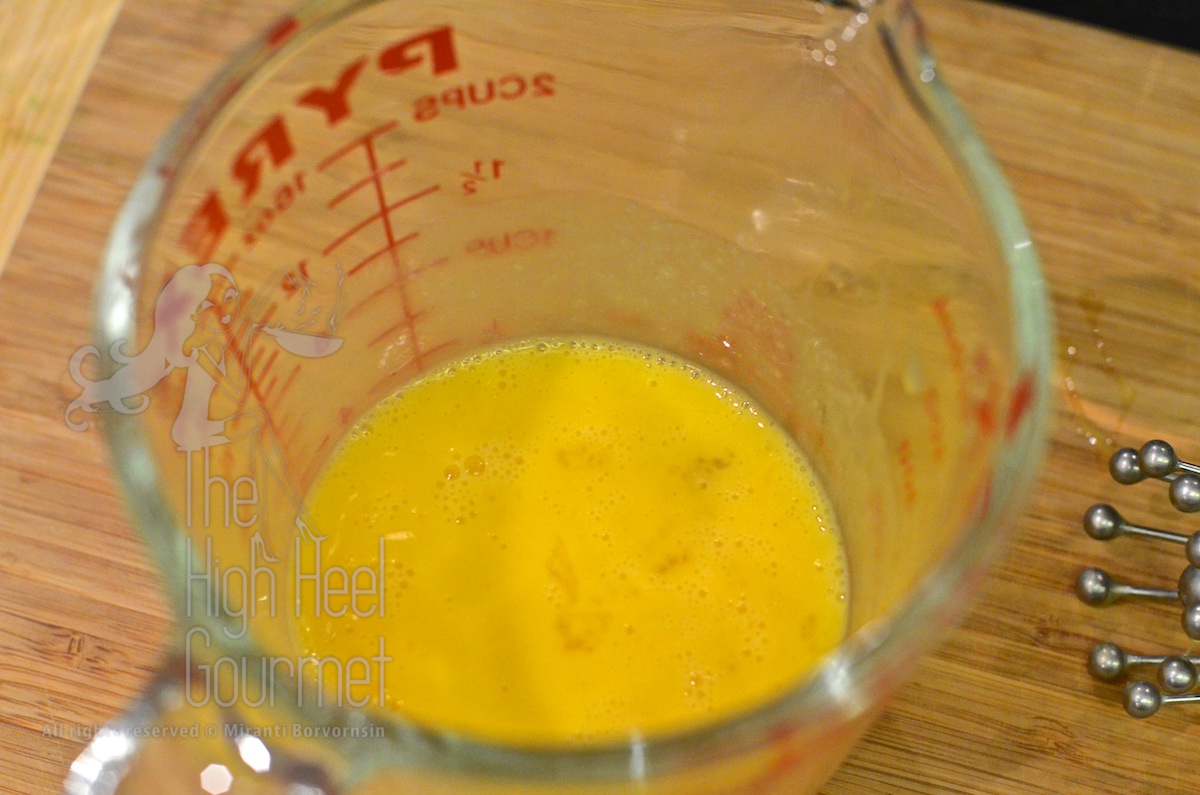
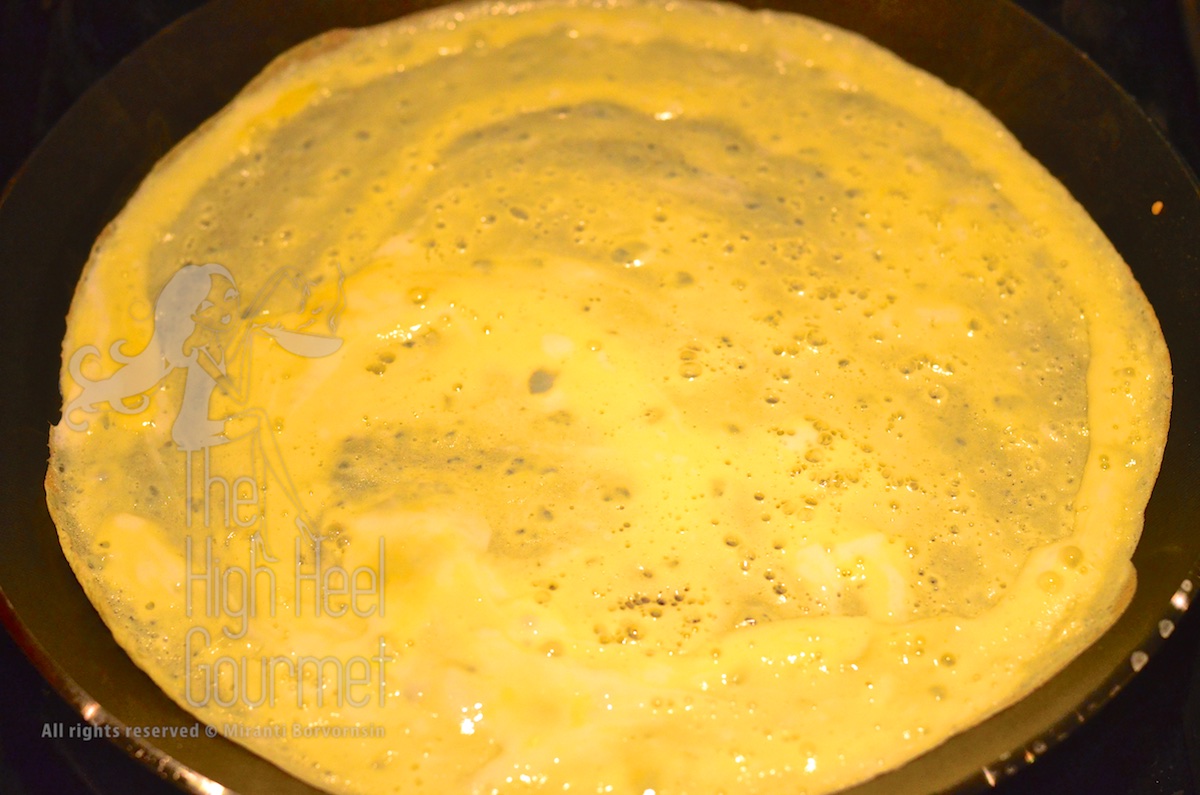
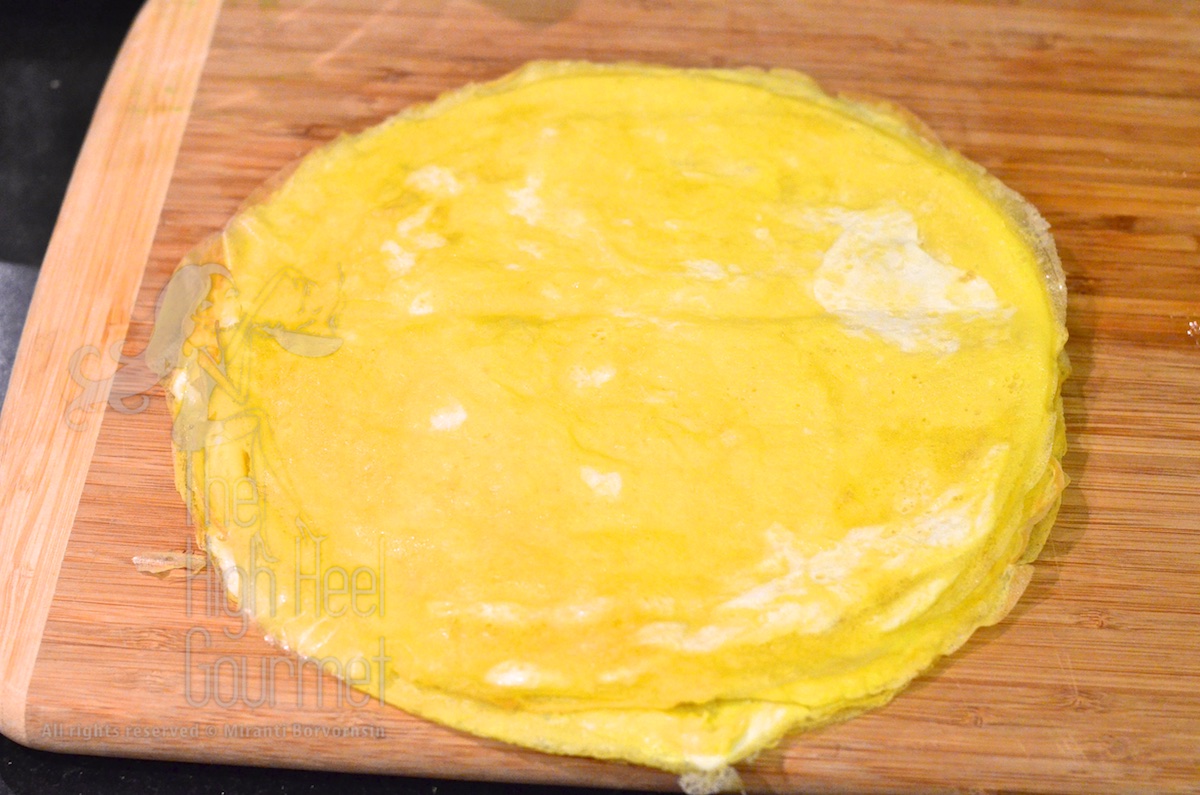
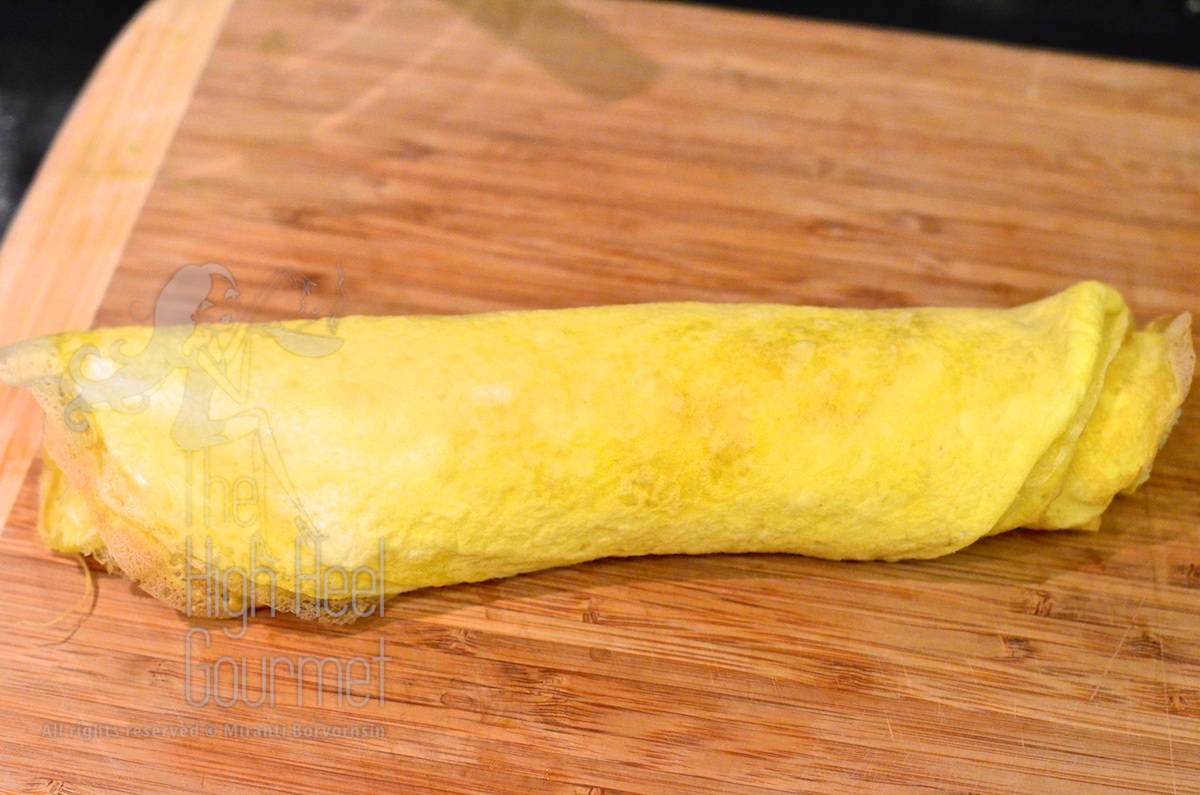
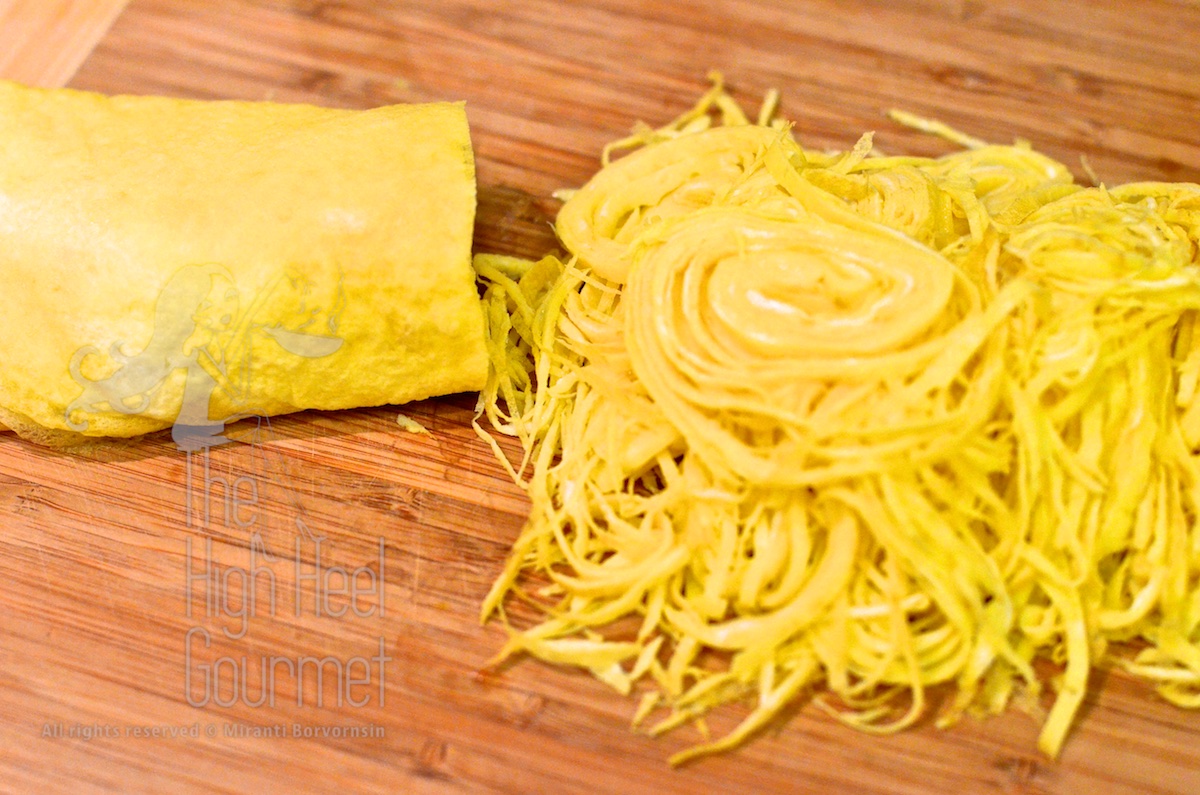
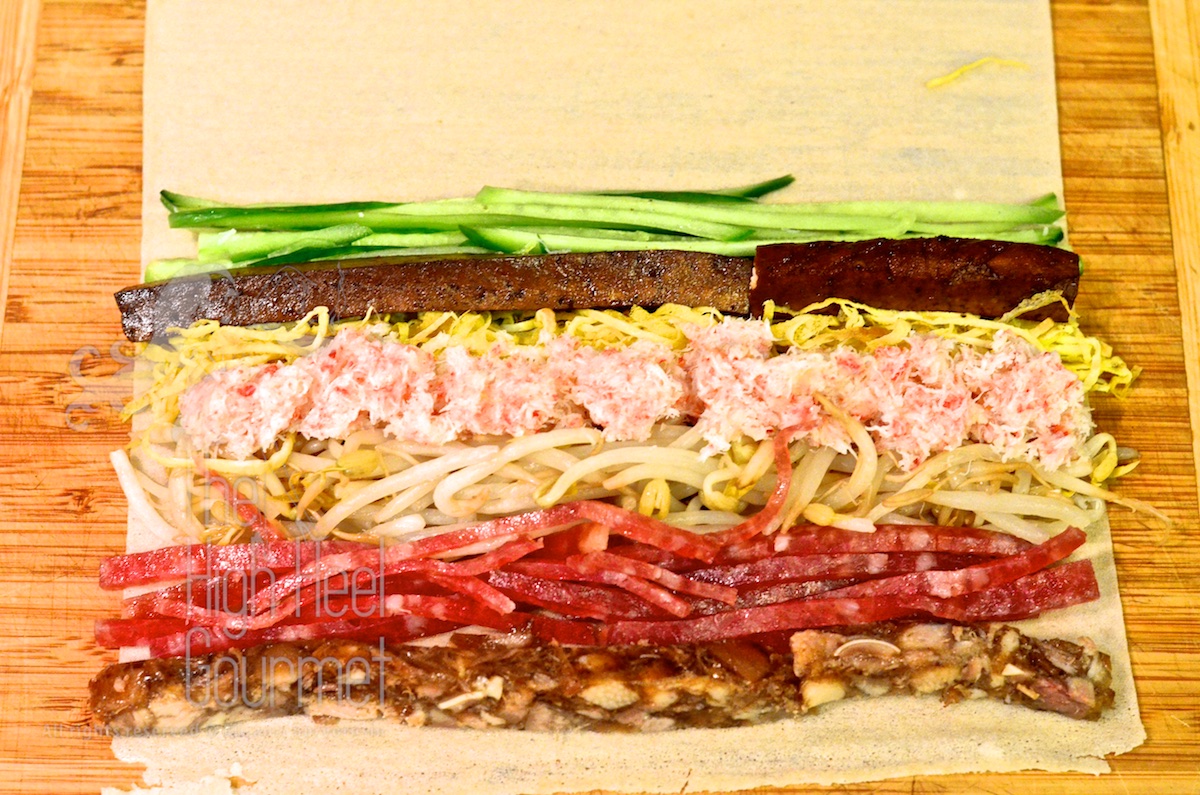
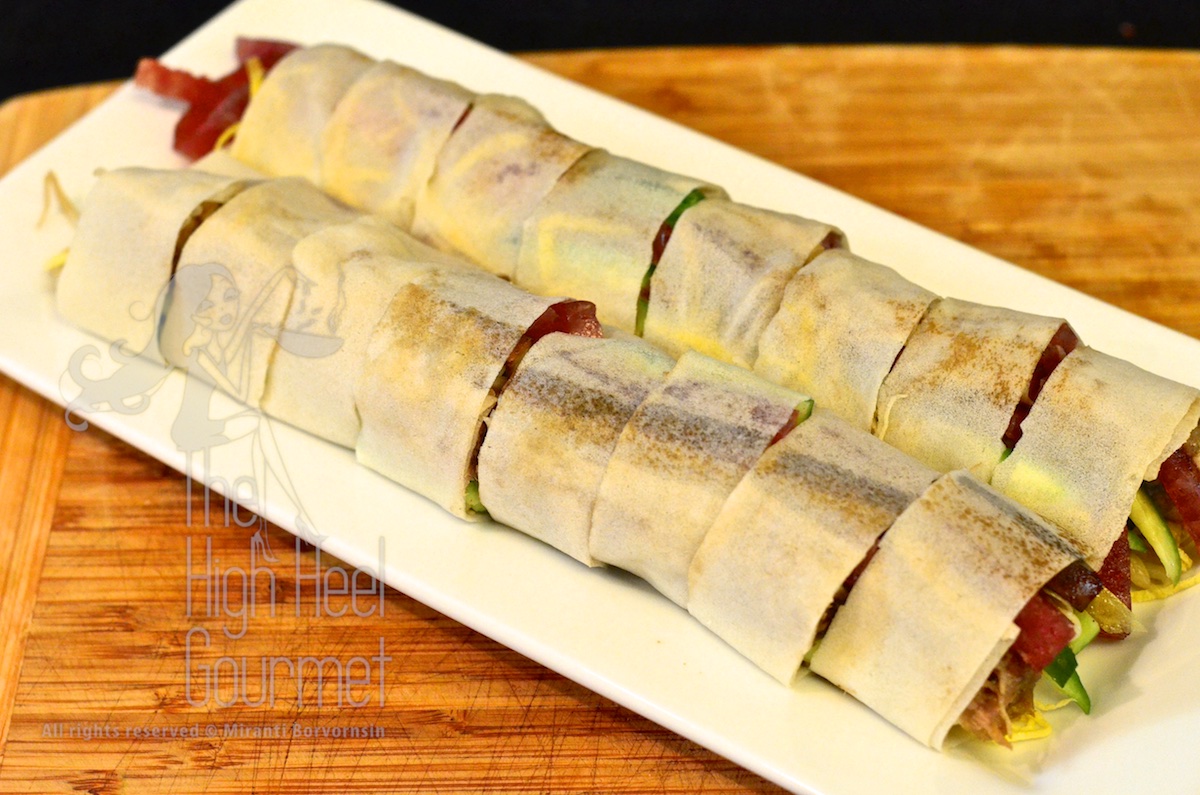
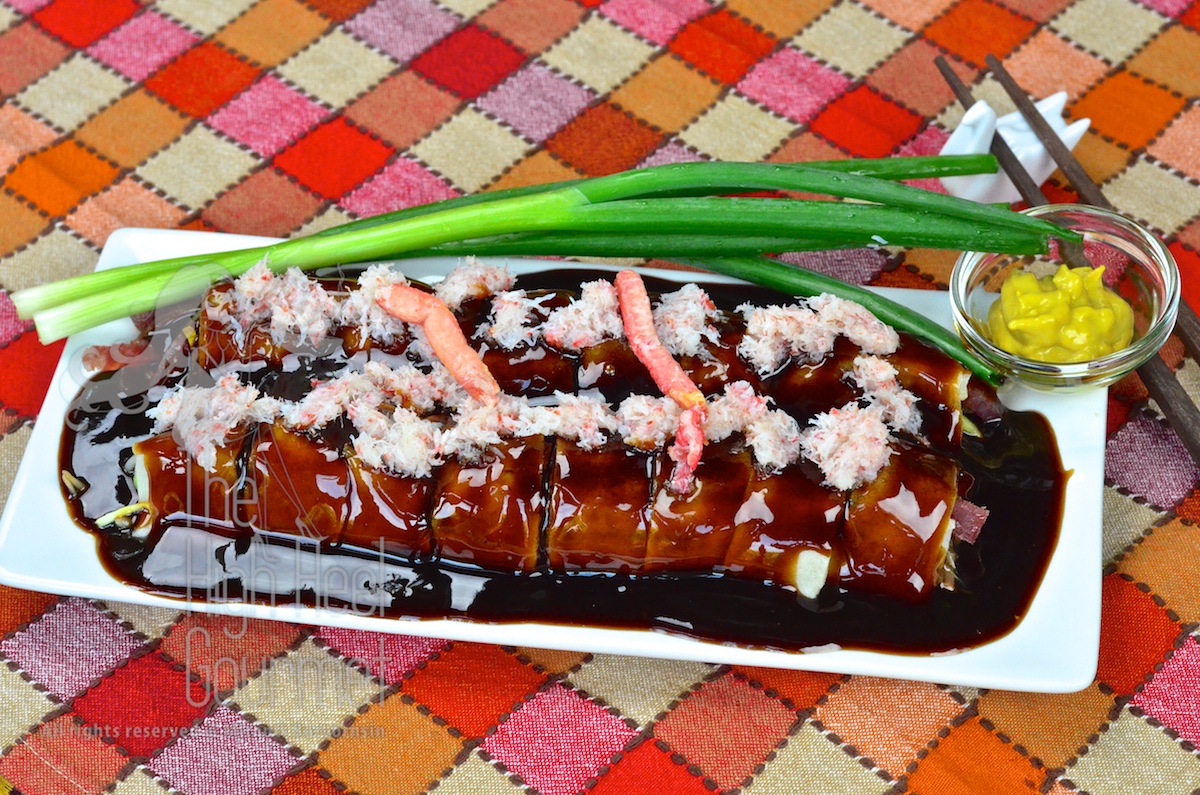
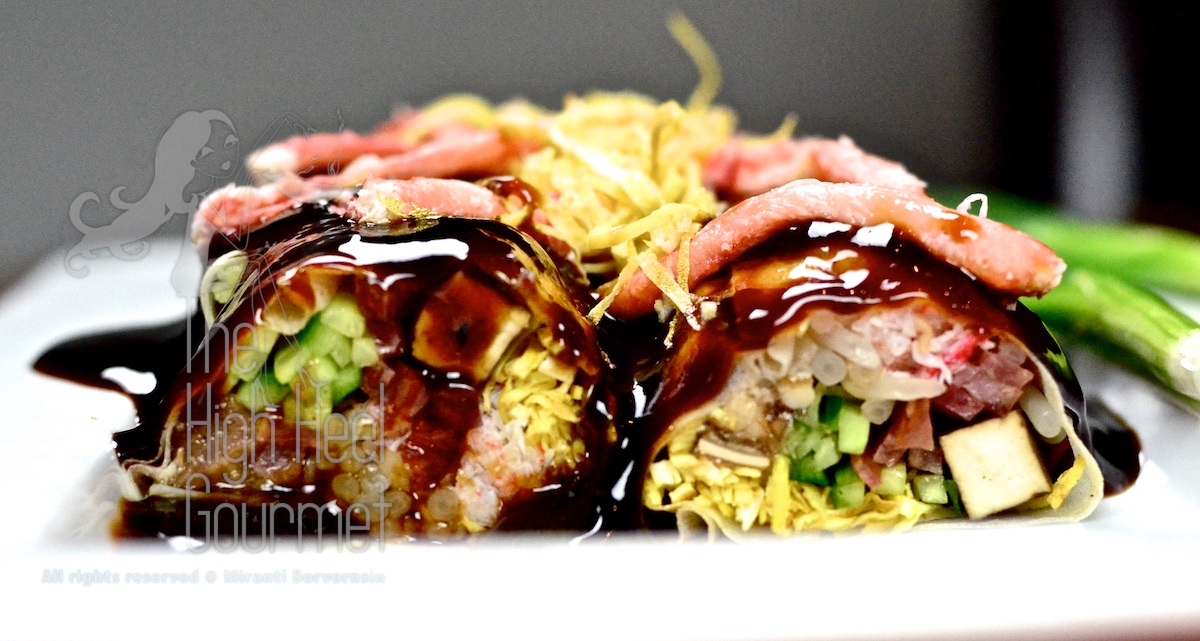
I’m certainly going to try this 🙂
Yes, so delicious. I have a friend already tried it last night and use SPAM instead of the rillettes and she loved it!
I’m certainly going to try this 🙂
looks great..
Thanks
Looks delicious…!
🙂 Thanks
Your photos are always so gorgeous. What kind of lighting are you using? Do you have special photographic lights?
Search this on Amazon H9004SB2. They are really reasonable and wouldn’t blow your circuit breaker.
I want one! 🙂
You can have two 😉
G’day! This looks delicious, true!
Great photos and is now on my list to also do!
Cheers! Joanne
Thanks!
Improving the light source is the easy way to improve the photos.
Cheers!
G’day! This looks delicious, true!
Great photos and is now on my list to also do!
Cheers! Joanne
This looks sooo fantastic!!
and it is fantastic! 🙂 Thanks
Wow… Great knife action there! Beautiful “juliennes” on the egg! Congratulations. I am jealous!
lol…it’s not as hard as julienne the green papaya 😉
It is really delicious.
Love this one.
P.S. :
Your rilettes are actually “Head Cheese” in french cooking.
One of my all time favorite dishes 🙂
Hans Thanks so very very much. I looked it up on the internet and found exactly what it is and it is exactly this rillettes! I had head cheese in Germany long long time ago but I didn’t know what it really was. It was so sour, must be the one marinade in vinegar but taste so familiar (no doubt why isn’t it…lol). I never give it a second thought plus didn’t know how to make them (What a shame?)
I thought the term rillettes is only 60% correct because it wasn’t cook in oil like most rillettes or meat hasn’t been cured but it was the only one I knew that was close enough to this.
Thanks so much for sharing your knowledge so I can learn too 🙂
Reblogged this on The ObamaCrat™.
Thanks!
My pleasure, happy Sunday.
Reblogged this on The ObamaCrat™.
Delicious looking comfort food!! 🙂
Agree 😀
That looks delicious. In Malaysia, street vendors sell this type of po-piah as well. It is a real treat just to watch the assembly, and the taste…out of this world. Thank you for sharing.
I loved to watch the assembly too. I love the way the vendor arranged all the fillings like the assemble line in a factory and they can make two rolls together in about 30 seconds, cut and already on the plate! Amazing. (I fact I watch because they usually lined two sheets stacked half on top of each other and I was wondering how do they separate them…lol…)
From what I remember the one in Malaysia added some sesame to the sauce too, isn’t it.
Love this, my favorite!!!
Mine too…I hope you can find ingredients to make them naka.
This looks so delicious! You have no idea how much I’m craving Asian food after almost a month of travelling around Europe with my visiting family. Actually, not even Asian food, just home cooked food in general!
I do know what do you mean. My usual adventure trip would take about 2-3 weeks and if the trip was in Europe, Africa, Australia at the end of the second week, I started to crave rice…lol…Yeah just rice and omelette with fish sauce (http://www.highheelgourmet.com/2012/11/14/thai-crispy-omelette/), home cooked food just like yours. There might be a few country that I don’t feel the need to eat my home cook, Italy, Spain and may be Mexico but I always carry my fish sauce to Mexico though…lol…
Yummy!!!!!!!!! This is one of the best food blogs on the net!
🙂 Thanks!
Yummy!!!!!!!!! This is one of the best food blogs on the net!
These are so beautiful, and must be full of flavor! Thanks for sharing how to make them in such detail and explaining what the ingredients are. That helps a lot!
These are so beautiful, and must be full of flavor! Thanks for sharing how to make them in such detail and explaining what the ingredients are. That helps a lot!
So, the wrappers are not cooked? Kinda like the Vietnamese rice paper, yeah? I’ve had this kind of spring rolls before, but the wrappers were freshly made and cooked like crepes before filling.
The wrapper is cooked while they made it (before frozen). It’s wheat flour though not the rice paper. This is the one using rice paper http://www.highheelgourmet.com/2012/03/06/spring-rolls/. The freshly made wrapper is nice. This kind of wrapper is fun to watch while they made it. Here this is the video https://www.youtube.com/watch?v=hU6FNI_cdOA. Did you see them made it this way?
If they made it over the steamer, then that’s the rice flour wrapper.
Yes! How did she do that?
It’s just the gluten with egg white salt and water at the right amount. Gluten would make the dough stretchy and the pan is hot. It’s hard to explain. I made that once in a while but I can’t do that with the small amount of flour because my hand would be burned.
Looks sooooo delicious and fresh!
This looks so delicious. Gotta try. 🙂